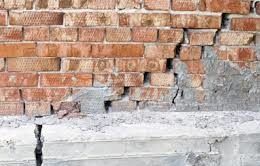There are two types of foundation settlement: differential and uniform. Differential foundation settlements happen at differing rates and between different portions of a building. When there is inconsistency in soils or structural systems between parts of a building it may cause different parts of a building structure to settle by substantially varying degrees. A majority of foundation failures are attributable to severe differential settlement.
Uniform foundation settlement is just the opposite. It occurs at nearly the same rate throughout all portions of a building. If all parts of a building rest on the same kind of soil, then uniform settlement is the most probable to take place. Although there may be less noticeable consequences, it still causes small detrimental influences on building safety.

Uneven foundation settlement may force buildings to shift and lead to crack initiation in foundation, structure, or finish. Consequently, the frame of a building may become distorted causing floors to slope, walls and glass to crack, and doors and windows to not work properly. No matter the type of foundation settlement problem, it’s an issue to fix sooner rather than later.
What Causes Foundation Settlement?
Concrete slab foundations frequently suffer from settlement problems over time. Many factors can cause these issues. One of the most common causes many home and business owners experience is due to soil conditions. Some concrete slab foundations are poured in areas that require the addition of loose soil. If the added soil is not adequately leveled and tamped, the soil beneath the slab is susceptible to settling. When this happens it leads to cracking or breaking of the slab. Additionally, when soil expands and contracts due to moisture levels, it can have an impact on a foundation.
Other foundation settlement issues can be caused by invasive roots from large trees or plants that are planted too close to a building. As roots extend, they can start growing beneath concrete slabs. It can be a problem especially for older or historic homes and buildings. Many old buildings have sewer lines made of copper piping prone to developing leaks. Leaks create moisture in the soil attracting the growing roots of nearby trees. As the roots gain a sufficient supply of moisture and nutrients to support growth, they can eventually grow long and big enough to cause an upheaval in the slab.
Mudjacking Solutions
When a foundation is uneven or starting to sink, mudjacking is a quick and easy way to effectively make the necessary repairs to correct any settlement issues with the foundation of a structure. Mudjacking, also commonly referred to as slab jacking, concrete lifting, or slab leveling, is a process that’s used when there are settlement issues with concrete. Mudjacking is a process that’s often used when there are settlement issues with concrete, whether its for porches, decks, patios, garage floors, or more importantly, foundations. Level Headed Mudjackers has the expertise to handle any mudjacking project. Contact us today if you think you need foundation repairs.
